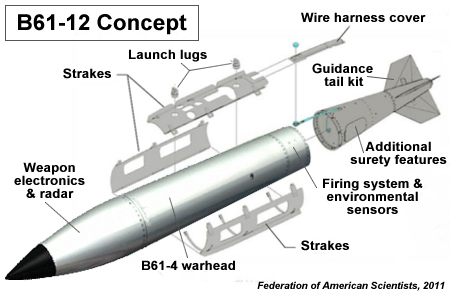I have been blogging recently about nuclear weapons. Unfortunately, it appears that another nuclear arms race may be underway. Nuclear powers are upgrading and expanding their arsenals while other states are trying to obtain nuclear weapons. Especially disquieting is the fact that the Russians are becoming increasingly belligerent and are rattling their nuclear saber at perceived enemies. They have announced the deployment new nuclear weapons and they are flying nuclear bombers off the coasts of other countries. They have also said that they may move nuclear weapons into the Crimea.
Tactical nuclear weapons include nuclear mortars and other artillery pieces capable of firing nuclear shells. These nuclear payloads are low yield in the kiloton range. Military planners designed these weapons to be used on the battlefield. There is a serious concern that if tactical nuclear weapons are used in a war, things could quickly and easily escalate into a full scale nuclear war that would destroy human civilization. Most tactical nuclear weapons were removed from Central Europe in the 1980s and 1990s.
The Russians have been publicly discussing force levels and weapons availability for different nations as well as NATO in the context of a possible war in Eastern Europe. One thing they emphasized is that Russia has more conventional weapons than the NATO alliance. The Russians have also pointed out that they have superiority in tactical nuclear weapons that they could easily deploy in case they were losing a conventional war in Eastern Europe.
The U.S. has B61 tactical nuclear bombs deployed in 5 NATO countries. There are currently four different types of B61 air-launched nuclear gravity bombs. These bombs are provided to NATO as part of the nuclear sharing initiative. The current B61s are being replaced with the new B61-12 which consolidates the previous designs into a single design. This work will include turning the free-fall bombs into more accurate precision guided bombs. They are scheduled to be deployed by 2020.
In early 2010, NATO decided to remove its nuclear missile shield for Eastern Europe. At the same time, the U.S. and Russia signed a new Strategic Arms Reduction Treaty. Against this trend toward nuclear disarmament, plans for the modernization of the B61 tactical nuclear bombs were announced in April of 2010.
The increasing belligerence and desperation being exhibited by Russia is stimulating interest in NATO in being prepared to meet a Russia military action against any of their members. Russia may be planning on pulling the same sort of subversive invasion they carried out in Ukraine in an Eastern European NATO member such as Latvia or Estonia. Both of these countries have substantial populations of ethnic Russians living near their borders with Russia. Infiltration by Russian agent provocateurs could stir rebellion in their borders regions. Russia might be trying to see if they can move against NATO members without a strong response from NATO. If this proves to be the case, then Russia will be able to intimidate such countries into accepting Russian domination.
